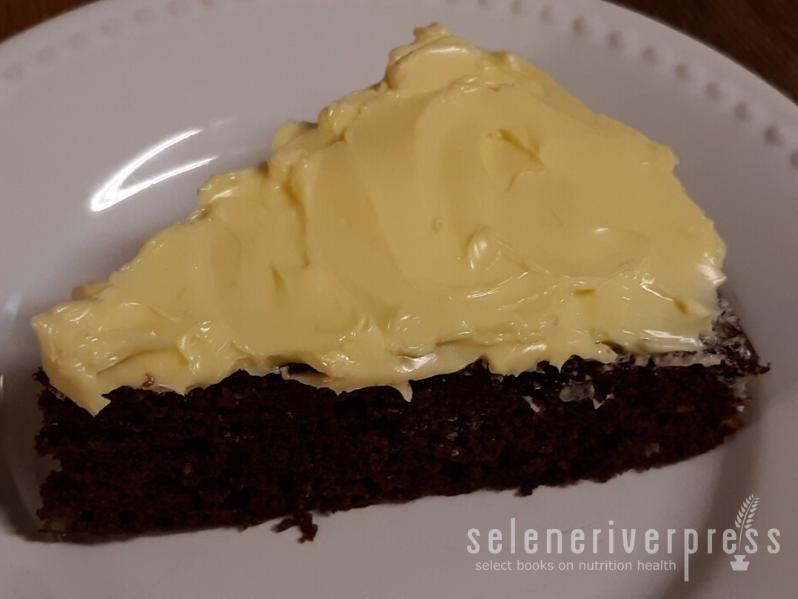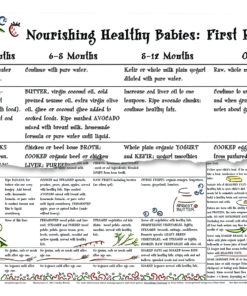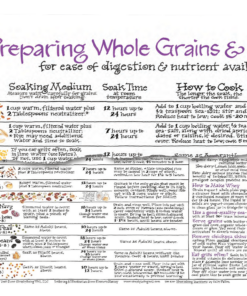Everyone loves chocolate cake. (Well, nearly everyone.) I created this recipe one evening after dinner, when my husband said that he’d love a piece of chocolate cake. I told him to give me about an hour, and he’d have one!
We’ve been eating GAPS-style at my house for years now. And for a few years prior to that, we followed the principles laid out in Sally Fallon’s book Nourishing Traditions as well as the Weston A. Price Foundation. (Dr. Price is the author of Nutrition and Physical Degeneration, a landmark study on nutrition science.)
All of this is just to say that I’ve learned the value of prepping ahead. I always have something soaking or fermenting on the counters, and most days I’ve got some stock on the stove. This is why I just “happened” to have almond flour fermenting on the counter. This takes 48 hours, and lucky for us it was ready to use. After I made this cake, my husband slathered on some of what he calls “Nature’s Frosting”—room temp, grass-fed butter. I encourage you to do the same. Delicious!
Monica’s Chocolate GAPS Cake with
Fermented Almond Flour and Raw Cacao
Makes one (9-inch) round cake, but feel free to double the recipe for a layer cake!
Notes: If you use plain yogurt (rather than whey) and need to make it with store-bought organic milk (rather than raw), make sure of three things: that the milk is grass-fed; that it is not ultra-pasteurized; and that is has no fillers. Alternatively, you may use kefir rather than whey or yogurt, but it might make the flavor of the cake a bit tangy.
Also keep in mind that before you bake the cake, you will need to ferment the almond flour, which will take 48 hours. Do not skip this first step as it is what makes the cake fluffy. You may even combine the raw cacao powder from the cake ingredients with the almond flour and ferment them together (no need to change the amount of whey/yogurt/kefir).
Ingredients
For the fermented almond flour:
2¼ cups almond flour
½ cup whey (from yogurt, kefir, or cheese making), or ½ cup plain yogurt made from raw or organic whole milk, or kefir (see notes above)
For the cake:
Grass-fed butter, coconut oil, or ghee or duck fat, to grease the pan
3–4 tablespoons raw honey
3 large pastured eggs
1 tablespoon organic vanilla extract
¼ cup raw cacao powder (see note above)
½ teaspoon baking soda (aluminum free)
½ teaspoon sea salt
Fermented almond flour (use all from recipe)
For the Nature’s Frosting:
1 stick grass-fed butter, at room temperature
Instructions for Fermented Almond Flour
- Place almond flour in a medium bowl. Add in whey, yogurt, or kefir and mix well to combine (should be the consistency of cookie dough).
- Cover bowl with a plate and place on counter, out of the sun (room temperature should be at 68–72°F). Leave for 48 hours. When fermented, proceed with the cake.
Instructions for Cake
- Preheat oven to 350°F. To prevent the cake from sticking, prepare a 9-inch round pan by cutting a round of parchment to fit. Place the parchment in the pan, and then grease the bottom and sides with butter or another healthy fat as mentioned above.
- Gently warm the honey in a water bath until it is liquid. Meanwhile, in a small bowl, whisk 3 eggs with vanilla extract.
- Mix the cacao, baking soda, and sea salt in a medium bowl.
- Place fermented almond flour into your standing mixer (if you will be using a hand mixer, leave it in the bowl it is currently in). Add in the dry ingredients. Mix well. Pour whisked eggs and vanilla into the almond flour, and mix well. Add the melted honey, and mix well.
- Pour batter into the prepared pan, making sure it is evenly distributed. Bake for 25-30 minutes. The cake is done when a toothpick inserted into the center of the cake comes out clean.
- Let rest in the pan until cooled. Turn out onto a cooling rack, and cover with Nature’s Frosting—or eat it hot out of the oven, and the Nature’s Frosting will melt!
Tips for GAPS: Nuts and seeds are tough on the digestive system, so it is best to soak, sprout, or ferment them before cooking or eating them. Find out how in my new book, The Complete Cooking Techniques for the GAPS™ Diet. There is an entire section on seeds. Enjoy!




